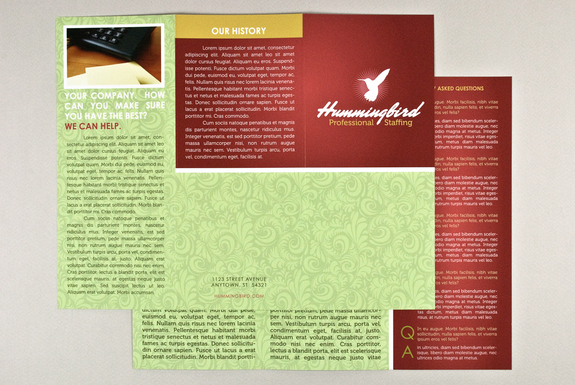|

The purpose of a brochure may vary from business to business. Some are designed to display services, whereas others are focused on selling an idea or product.
No matter what the focus of the brochure is, it needs to be readable, intriguing, and functional. The brochure must grab a viewer’s attention and hold it long enough to deliver the pertinent information.
The Two Main Styles Of Basic Brochure Design
Number One: This brochure is designed to attract attention.
(less written info more colorful images) It plays on the emotions of the customer. When they see it in a display rack they must pick it up and see what it says. It has an attention getting headline.
• How to write an effective headline
• How to Create an Effective Brochure
It is designed to spend all its time, on public display, exposed to as much of your target market as possible. It will contain lots of white space and short thoughts rather than long paragraphs. It contains a "call to action" that requires or asks the customer to make a phone call, come on down, clip a coupon, mail a reply card or some other action that puts you and the customer in contact.
Think of this brochure as the appetizer of your business. Something to tickle the pallet but still leave them hungry.
|


|
|
Number Two: For the existing customer (give detail)
This brochure is designed for the customer who has learned of your company and has requested more information. He/she may have seen your "Type One" brochure I described above. Unlike Type One, Type Two can be crammed with information. Customers who request information want to know everything. They become insatiable for product knowledge. No matter what you send, it may not be enough to satisfy some customers. Think of this brochure as the main course.
This style of brochure should never be used in display racks or laid out for the curious passerby. A casual customer who is unfamiliar with your business will be "turned off" by the thought of wadding through this mountain of information just to see what you do.
The Most Common Mistake Of Brochure Use
Have you ever heard the expression, "Don't send a boy to do a man's job?" Well, don't expect your brochure alone to make the sale for you. The purpose of a brochure is to educate the customer about the subject of the brochure and encourage that customer to get in contact with you. There are some small ticket items however, that can be sold with a direct mail brochure. These brochures are almost always Type One. They are usually more successful with some supporting documentation.
Remember the two points above: A call to action brochure anda brochure to educate in detail. The brochure should get you the appointment with the customer, but you must make the sale.
Used With Permission
©1998-1999 Eagle Marketing PO Box 271 Bozeman, MT 59771-0271
http://www.smalltownmarketing.com - (406) 585-0219
email: tommail@smalltownmarketing.com
|


|
Five Different Types of Brochure
When was the last time you bought something on a whim? We've all been the victim of the impulse buy but, for the most part, we're informed consumers.
Brochures usually come into play so you can make a smart buying decision. As someone selling a product or service, knowing what type of brochure you need to advertise your products and services is critical to turning your potential customers into paying customers.
1. Leave-Behinds
This type of brochure is named for the brochures you leave behind after meeting a potential customer. Write this type of brochure with a complete description of your product and its benefits.
Summarize your sales pitch to echo the one you just gave. Keep your words forever in their brain - or at least long enough to get them to buy your product.
2. Point-of-Sale
These are best described as the type you might encounter while standing in line at the bank. You notice a rack of brochures and it just so happens they're conveniently located right there for you to enjoy.
You didn't know you could get free checking if you bought a Certificate of Deposit. You take a brochure. You'll read about it later. Point-of-Sale.
Write a catchy headline and make sure you have a nice visual to work with the headline. Your goal is to get potential customers to see your brochure, be curious enough to pick it up and, even more
|
3. Respond to Inquiries
When people ask about your product, they're obviously interested. Sending this type of brochure is for a qualified buyer. They're qualified because they're much more likely to buy than someone who hasn't contacted you. Since they've already expressed interest, write this brochure to take your prospect to the next step: the buying process. Hammer home all of your sales points and pack your brochure with facts to convince them they can't live without your product.
4. Direct Mail
This is the type of brochure you include with your direct mail package. You know the sales letter sells but a brochure used with direct mail contains photos, your product's sales points and even technical features.
5. Sales Support Tool
Sales support is very similar to leave-behinds. The difference is, this type of brochure can be used as a selling aid.
Your salesperson uses them to guide them through their sales pitch. They have larger pages, larger photos and larger headlines.
Now that you know the types of brochures, figure out where they fit into the buying process for you. That way, you'll not only know the type of brochure you need, but how to write it as well. |




